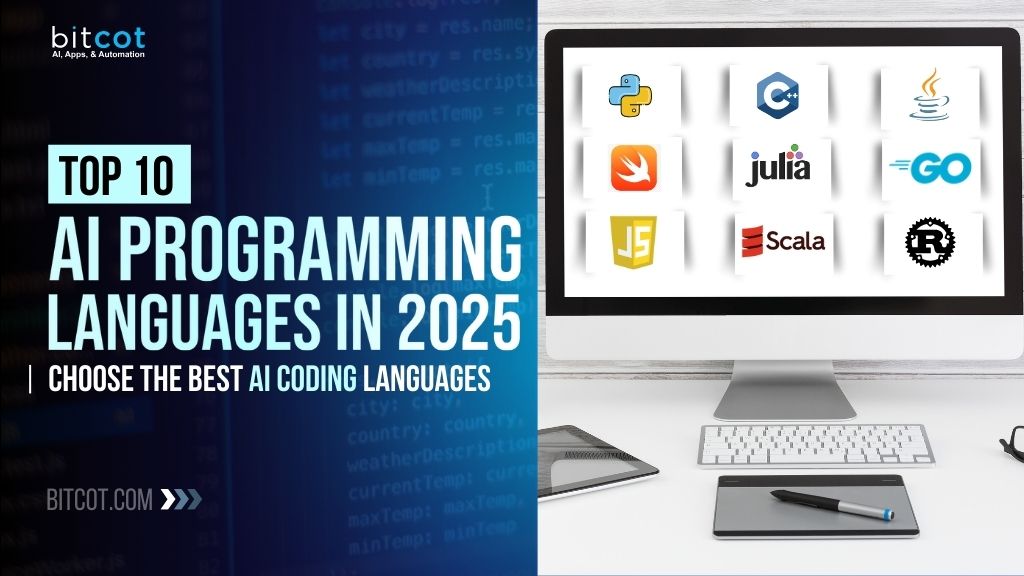
A single technology decision made in the next 30 days could either make your company $50 million richer or drive it toward irrelevance.
The artificial intelligence revolution is reshaping entire industries at breakneck speed. Fortune 500 companies are investing billions in AI initiatives, startups are disrupting traditional business models, and organizations that fail to adapt are becoming obsolete.
But here’s what most business leaders don’t realize: your choice of AI programming language will determine whether your AI initiative becomes a competitive weapon or a costly failure.
In 2025, the stakes have never been higher. The global AI market is projected to reach $1.8 trillion by 2030, and companies implementing AI solutions are seeing average revenue increases of 15%. Meanwhile, organizations that choose the wrong technology stack are burning through budgets and watching competitors capture market share.
Should you go with Python’s simplicity? Java’s enterprise reliability? Or explore emerging languages like Julia and Rust that promise superior performance?
The programming language you select today will determine your development speed, talent costs, system performance, and maintenance expenses. Make the right choice, and you’ll accelerate time-to-market while building competitive advantages. Make the wrong choice, and you’ll join the 70% of AI projects that fail.
This guide provides strategic insights for optimal AI programming language decisions. We’ll analyze the top 10 languages driving AI innovation in 2025 and show you how to avoid costly mistakes that derail AI initiatives.
Ready to discover which AI programming language will power your business transformation? Let’s dive into the challenges that keep enterprise leaders awake at night.
What Are Artificial Intelligence Programming Languages?
AI programming languages are the tools that power intelligent systems. They enable algorithms capable of learning from data, recognizing speech, interpreting information, and even supporting autonomous technologies. Each language comes with its own ecosystem of libraries and frameworks that make complex AI tasks more efficient.
Python is the most widely adopted, thanks to libraries like TensorFlow and PyTorch that simplify machine learning and deep learning. R is preferred for statistical analysis, while Java, Julia, and C++ each bring unique strengths for scaling, performance, or specialized AI projects.
You’ve likely made the strategic decision to bring artificial intelligence into your business. The board expects results, and competitors are already using AI for customer insights, automation, and market advantage. The challenge is clear: choosing the wrong AI programming language can set your company back years, costing millions in delays, inefficiencies, and lost opportunities.
Choosing wisely is critical. The wrong language may cause delayed time-to-market, rising costs, integration issues, or difficulty hiring skilled talent. The right choice provides a solid foundation for AI solutions that scale, integrate seamlessly, and deliver real business value.
Why Choosing the Wrong AI Programming Language Costs Businesses Millions
Every major business leader knows AI is the game-changer of this decade. But here’s the hard truth: not every AI project succeeds. One of the most overlooked yet critical factors is the programming language you build it on.
The brutal truth: 70% of AI projects fail not because of poor data or algorithms, but because organizations choose AI coding languages that don’t align with their business objectives, technical infrastructure, or team capabilities.
Here’s what’s happening in boardrooms across enterprises:
The Speed Trap: CTOs rush to adopt trendy languages without considering long-term maintenance costs. That cutting-edge language your team loves today might become a technical debt nightmare in 24 months.
The Talent Shortage Crisis: The most demanded AI coding languages in 2025 are Python and JavaScript, which join Java at the top of the list, but finding skilled AI developers in specialized languages can take 6+ months and cost 40% more in salaries.
The Integration Disaster: Your AI model works perfectly in isolation but breaks when connecting to your enterprise systems, costing weeks of additional development and testing.
The Performance Catastrophe: Your AI application performs beautifully with test data but crashes under real-world enterprise loads, forcing expensive infrastructure overhauls.
The cost of these mistakes? Companies report spending an average of $2.4 million on failed AI implementations before starting over with the right technology stack.
Now that you understand the risks of poor AI language selection, let’s explore the solution: a comprehensive guide to choosing the right programming language for your specific business needs.
How to Select the Right Programming Language for Enterprise AI Projects
The solution isn’t just picking the most popular language – it’s selecting the AI coding language that aligns with your business goals, technical requirements, and long-term strategy. Here’s your comprehensive guide to the top 10 AI programming languages that will drive your success in 2025.
With the framework established, let’s dive into the specific programming languages that are transforming enterprise AI development in 2025.
1. Python
Python has held its position as the most popular language for AI and machine learning (ML) for over a decade, and its reign continues in 2025. For business leaders, Python represents the perfect balance of development speed, talent availability, and enterprise readiness.
Business Impact:
- 45% faster development cycles compared to traditional languages
- Largest talent pool of AI developers globally
- Extensive library ecosystem reduces development costs by up to 60%
- Seamless integration with cloud platforms like AWS, Azure, and Google Cloud
Best for: Machine learning, data analytics, natural language processing, computer vision Enterprise Use Cases: Customer recommendation systems, fraud detection, predictive maintenance
Bitcot Advantage: Our Python development teams have delivered 200+ enterprise AI solutions with 95% client satisfaction rates
2. Java
Java remains the backbone of enterprise software, and its role in AI development continues to grow. The top programming languages for artificial intelligence include Python, Java, and R, while Rust, Julia, and Scala are gaining recognition in AI-driven research and enterprise applications.
Business Benefits:
- Platform independence ensures your AI runs anywhere
- Superior performance for large-scale enterprise applications
- Strong security features meet enterprise compliance requirements
- Massive developer ecosystem and long-term support
Best for: Enterprise-grade AI applications, distributed systems, web-based AI services
Enterprise Use Cases: Real-time trading systems, large-scale recommendation engines, enterprise chatbots
Investment ROI: Java-based AI projects show 23% better long-term maintenance cost efficiency
3. R
R transforms raw data into strategic business insights. For enterprises drowning in data but starving for actionable intelligence, R provides the statistical computing power to turn information into competitive advantage with advanced analysis capabilities unmatched by other languages.
Best for: Statistical analysis, data mining, business intelligence, risk assessment
Enterprise Use Cases: Market research analysis, financial risk modeling, customer segmentation
Business Impact: Companies using R for data analysis report 31% better decision-making accuracy
4. JavaScript
JavaScript breaks down the barriers between frontend user interfaces and backend AI logic, enabling rapid prototyping and deployment of AI-powered web applications with single language for entire application stack and real-time artificial intelligence capabilities.
Best for: Web-based AI applications, real-time AI interfaces, AI-powered dashboards
Enterprise Use Cases: Interactive AI analytics dashboards, real-time customer service chatbots, AI-powered web applications
Time-to-Market: JavaScript AI projects deploy 40% faster than traditional architectures
5. C++
When milliseconds matter and computational efficiency directly impacts your bottom line, C++ provides the performance edge with maximum computational efficiency, direct hardware control, superior memory management, and industry standard for robotics applications.
Best for: Real-time AI systems, robotics, computer vision, high-frequency trading AI
Enterprise Use Cases: Autonomous vehicle systems, real-time fraud detection, industrial automation
Performance Advantage: Up to 10x faster execution compared to interpreted languages
6. Julia
Julia combines the ease of Python with the performance of C++, making it ideal for computationally intensive AI research with near-C++ performance, Python-like syntax, built for parallel computing, and growing ecosystem of artificial intelligence libraries.
Best for: Scientific AI research, high-performance computing, numerical analysis
Enterprise Use Cases: Financial modeling, climate prediction models, pharmaceutical research
Performance Edge: Julia delivers scientific computing performance 2-10x faster than Python
7. Scala
Scala bridges the gap between object-oriented and functional programming, making it ideal for big data AI applications with native Apache Spark integration, functional programming paradigms for parallel processing, and strong type system preventing runtime errors.
Best for: Big data AI processing, distributed machine learning, stream processing
Enterprise Use Cases: Real-time analytics on massive datasets, distributed AI model training, streaming data analysis
Scalability Factor: Handles datasets 100x larger than traditional approaches
8. Swift
As AI moves to mobile devices and edge computing, Swift provides the performance and integration needed for sophisticated on-device AI applications with optimized iOS performance, seamless Apple AI framework integration, and growing server-side support.
Best for: Mobile AI applications, on-device machine learning, iOS AI integration
Enterprise Use Cases: Mobile business intelligence apps, on-device AI assistants, edge computing.
Market Opportunity: Mobile AI market projected to reach $26.4 billion by 2025
9. Go
Go’s simplicity and powerful concurrency model make it perfect for building cloud infrastructure that supports enterprise artificial intelligence applications with excellent concurrency support, fast compilation cycles, strong networking capabilities, and efficient cloud resource utilization.
Best for: AI microservices, cloud infrastructure, AI API development
Enterprise Use Cases: AI service orchestration, cloud-native AI platforms, AI API gateways
Cloud Efficiency: Go-based AI infrastructure uses 30% fewer cloud resources
10. Rust
Rust, Julia, and Scala are gaining recognition in AI-driven research and enterprise applications. Rust’s memory safety guarantees make it increasingly important for artificial intelligence systems where reliability is paramount with zero-cost abstractions and guaranteed memory safety.
Best for: Systems programming, safety-critical AI, blockchain AI integration
Enterprise Use Cases: Autonomous systems, financial AI infrastructure, IoT AI applications Reliability Advantage: Zero-cost abstractions with guaranteed memory safety
After exploring these 10 powerful programming languages, you need a systematic approach to make the right choice for your organization. Here’s the decision framework that leading enterprises use.
How to Choose the Right AI Programming Language: Decision Framework for CTOs
Step 1: Assess Your Business Objectives
- What specific business problems are you solving with AI?
- What’s your timeline for deployment and ROI expectations?
- How critical is performance vs. development speed?
Step 2: Evaluate Your Technical Infrastructure
- What existing systems need AI integration?
- What’s your cloud strategy and preferred platforms?
- What are your security and compliance requirements?
Step 3: Consider Your Team and Resources
- What’s your current development team’s expertise?
- What’s your budget for talent acquisition and training?
- How important is long-term maintainability?
Step 4: Plan for Scale and Evolution
- How will your AI needs evolve over the next 3-5 years?
- What’s your strategy for scaling AI across the organization?
- How will you handle future technology transitions?
Having a clear decision framework is crucial, but successful implementation requires the right development partner who understands both technology and business strategy.
Why Choose Bitcot for Enterprise AI Development Services
At Bitcot, we don’t just write code – we architect AI solutions that drive business transformation. Our approach combines deep technical expertise across all major artificial intelligence programming languages with strategic business acumen to deliver solutions that exceed expectations.
Our Proven Methodology:
- Strategic Assessment – We analyze your business objectives and technical requirements
- Technology Selection – We recommend the optimal programming language stack for your needs
- Agile Development – We deliver working AI solutions in rapid iterations
- Enterprise Integration – We ensure seamless integration with your existing systems
- Ongoing Optimization – We continuously improve performance and capabilities
Why Enterprise Leaders Choose Bitcot:
- 200+ successful AI implementations across industries
- 95% client satisfaction rate with on-time, on-budget delivery
- Expert teams in all major AI programming languages
- Proven track record with Fortune 500 companies
- Comprehensive post-deployment support and optimization
Industry Expertise:
- Healthcare: HIPAA-compliant AI solutions for patient care and diagnostics
- Finance: Regulatory-compliant AI for fraud detection and risk management
- Retail: AI-powered recommendation engines and customer analytics
- Manufacturing: Predictive maintenance and quality control AI systems
- Technology: Scalable AI platforms and machine learning infrastructure
Understanding your options and having the right partner is just the beginning. The real transformation happens when you take decisive action to implement AI solutions that drive measurable business results.
Let’s Transform Your Business with AI in 2025
The AI revolution isn’t coming – it’s here. Every day you delay implementing AI solutions is another day your competitors gain ground. The programming language you choose today will determine your AI success for years to come.
Your Next Steps:
- Schedule Your Free AI Strategy Consultation – Our experts will assess your specific needs and recommend the optimal AI programming language strategy for your business.
- Download Our Enterprise AI Readiness Assessment – Evaluate your organization’s readiness for artificial intelligence implementation with our comprehensive 50-point checklist.
- Request a Custom AI Development Proposal – Get a detailed proposal outlining how we’ll implement AI solutions using the right programming languages for your specific requirements.
Ready to Lead Your Industry with AI?
Don’t let programming language confusion delay your AI transformation. Contact Bitcot, a trusted AI development company, and discover how the right artificial intelligence programming language strategy can drive unprecedented growth and competitive advantage for your business.
Contact Bitcot Now:
- Schedule your consultation: calendly.com/bitcot
- Email us: support@bitcot.com
- Call us: +1 858-683-3692
The future belongs to businesses that act decisively on AI. Make 2025 the year you transform your industry with the power of artificial intelligence.












